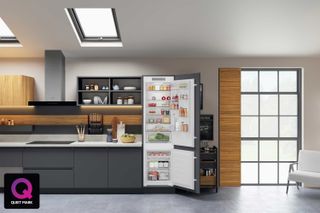What are the energy ratings for appliances? Energy labels explained
The new energy rating for appliances may look the same as the old, but there are key differences. Confused about the new energy labels? Here's a handy guide

Last year the UK introduced new energy rating for appliances, replacing the consumption ratings introduced by the EU in 1995, to help consumers find appliances that use the least amount of energy.
The new energy label tosses out the confusing A+, A++ and A+++ ratings and replaces it with an A to G scale, with A being the most efficient product of its class, and G being the least efficient. This appliances to most kitchen appliances, like thebest integrated dishwashers, but not all — ovens, for instance, are not covered. It aims to make purchasing decisions easier and encourage manufacturers to design even more sustainable products.
Here, we answer your questions key questions regarding the energy consumption ratings for appliances.
What are the new energy ratings for appliances?
There is one single scale for most products, covering from A to G. The old scale of A+, A++ and A+++ is not in use anymore for many appliances, but the colour scale in the label hasn't been changed because it is so recognisable to consumers.
The ratings currently only affect washing machines, washer-dryers, dishwashers, refrigerators, lighting and TVs, with tumble-dryers, ovens and other appliances remaining the same for now.
A new element in these labels is a QR code with which consumers will be able to get additional information by scanning the code with a smartphone.
An example of the new ratings is theMiele WER865WPS(opens in new tab)Freestanding Washing Machine which has an A rating, while Zanussi’sZWF142E3PW model(opens in new tab)has a C rating. The Zanussi model may seem far less energy efficient, but C is still good under the new system. Very few models have achieved the A rating.
Why was a new energy ratings for appliances scale introduced?
Under the old system, 90% of products were rated A+++. The system of pluses could no longer express advancements clearly as newer and more energy-efficient products were released.
It is now far harder for appliances to be rated as A or B, leaving room for further efficiency improvements and hopefully driving brands to become more eco efficient than ever before.
These changes are designed to push manufacturers to meet tighter restrictions to achieve the top energy rating, and ultimately is good news for consumers.
The energy labels will display not only electricity consumption, but also other energy and non-energy information to compare products and allow consumers to make better-informed purchase choices.
This non-energy information varies by product and includes water used per washing cycle, storing capacity, noise emitted, total volume in litres of all the chilled and frozen compartments in your fridge freezer, and more.
Luke Shipway, product manager atCaple Appliances(opens in new tab), said: “As energy bills soar, it makes perfect sense to look more closely at energy-efficient appliances for your home.
"In fact, millions of UK households have seen an unprecedented increase with the recent energy price cap hike. Of course, this sort of impact could be huge for many.
"So, if you’re looking for new appliances for your home, why not consider more energy-efficient models? After all, these will be kinder to your pocket in the long run."

在哪里我的+ + +设备适应新的sca吗le?
As a very rough estimate, products that were once classified as A+++ are now likely to be rated as B/C, with A++ as D/E and A+ as F/G.
You may be asking doenergy efficient save you money?Despite the appearance that ratings may appear quite low, household appliances haven’t become less efficient, they are just rated differently. For example, most fridge freezers rated A+++ on the old scale are now D — it’s just the scale of ratings that have changed.
Jo Jackson, Fisher & Paykel’s market product manager for UK and Ireland, said: “The industry has made great inroads recently in improving the energy efficiency of household appliances and this has led to ratings at the A+++ level being overpopulated to a point where manufacturers have been adding a percentage value.
“For example, where the appliance is 50% more efficient than A+++, this would be written as “A+++ - 50%” and this has led to great confusion. Effective from March 2021, this previous labelling system was retired in favour of the existing A-G ratings.
“While the requirements are now stricter than before, the return to the existing A-G ratings creates less confusion among consumers.
“This change means that most appliances will no longer have their A and B-grade energy efficiency levels. What were previously rated as A+++ appliances may have fallen to a C level, and previously C levels may have fallen to E levels as they were rescaled.
“Appliances will be just as efficient as they were before, but now very few appliances are categorised at the new A level. In essence, this is a recalibration in the framework that allows for better efficiencies going forward, and much better clarity for consumers.”
Get the Homebuilding & Renovating Newsletter
Bring your dream home to life with expert advice, how-to guides and design inspiration, direct to your inbox.
Sam is based in Coventry and has been a news reporter for nearly 20 years. His work has featured in the Mirror, The Sun, MailOnline, the Independent, and news outlets throughout the world. As a copywriter, he has written for clients as diverse as Saint-Gobain, Michelin, Halfords Autocentre, Great British Heating, and Irwin Industrial Tools. During the pandemic, he converted a van into a mini-camper and is currently planning to convert his shed into an office and Star Wars shrine.
Most Popular
Thank you for signing up to Homebuilding. You will receive a verification email shortly.
There was a problem. Please refresh the page and try again.
